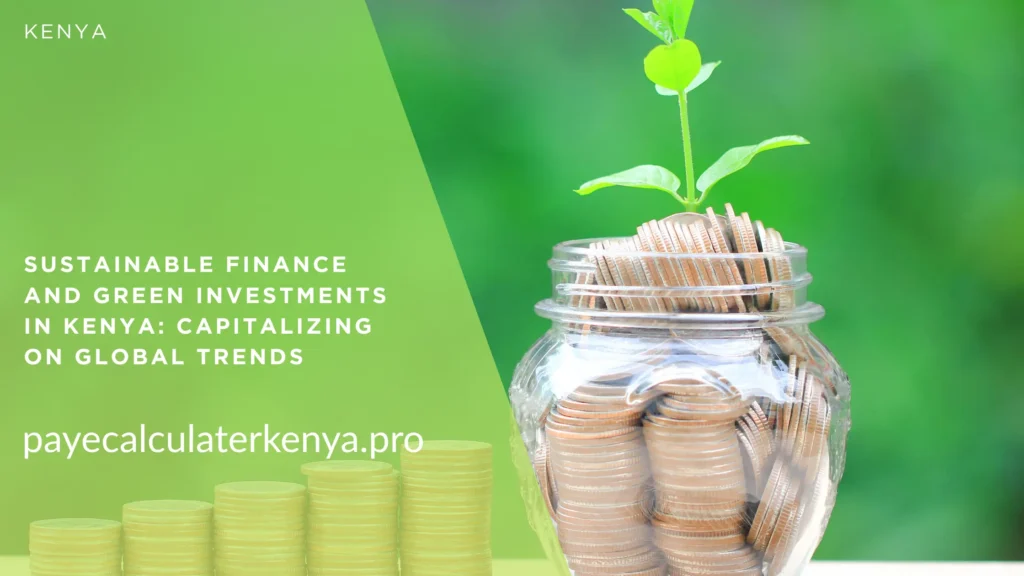Sustainable Finance and Green Investments in Kenya: Capitalizing on Global Trends
Kenya’s sustainable finance sector thrives in 2025, driven by global demand for green investments. The Finance Act 2025 and initiatives like the Kenya Green Finance Taxonomy fuel opportunities in green bonds, renewable energy, and agribusiness. These align with environmental goals, offering investors, environmentalists, and financial advisors profitable and impactful prospects. This guide explores green finance options, government initiatives, and investment benefits, using trusted sources like MyJobMag and the African Development Bank.

Why Sustainable Finance Is Growing
Kenya’s 5.3% economic growth in 2025 supports sustainable finance. Climate change threatens agriculture, pushing demand for green solutions. The Kenya Green Finance Taxonomy defines eco-friendly investments, aligning with global standards like the EU Taxonomy. Green bonds and renewable energy projects attract international funds, like the $70M Climate Investment Funds for clean energy. Over 20 green bonds issued in Africa by 2023 fund sustainable projects, with Kenya leading in East Africa.
Top Green Finance Options
- Green Bonds: Fund renewable energy, sustainable agriculture, and green infrastructure with 10–12% returns.
- Example: Kenya’s 2019 KES 4.3 billion green bond built eco-friendly student housing.
- Renewable Energy: Solar and geothermal projects offer 12–18% returns, supported by tax exemptions.
- Example: A 35MW solar plant funded by green bonds yields steady profits.
- Agribusiness: Climate-smart farming, like organic fertilizer plants, provides 15–20% returns.
- Example: Agro-processing ventures benefit from VAT exemptions on inputs.
- Green Infrastructure: Roads and energy-efficient buildings attract concessional loans.
- Example: $600M in road projects funded by green finance in 2025.
- Youth Employment Projects: Initiatives like Green Finance for Youth Employment create jobs.
- Example: Solar training programs employ 1,000 youths yearly.
| Investment Type | Return Potential | Key Benefit |
|---|---|---|
| Green Bonds | 10–12% | Funds eco-friendly projects |
| Renewable Energy | 12–18% | Tax incentives |
| Agribusiness | 15–20% | Supports food security |
| Green Infrastructure | 10–15% | Government backing |
| Youth Employment | Social impact | Job creation |
Government Initiatives Driving Growth
- Kenya Green Finance Taxonomy: Defines green investments, focusing on climate mitigation and adaptation.
- Climate Risk Disclosure Framework: Ensures banks report climate risks, boosting transparency.
- Tax Incentives: VAT exemptions on renewable energy and agricultural inputs lower costs.
- Nairobi International Finance Centre (NIFC): Promotes green finance hubs for investors.
- Climate Investment Funds: $70M for clean energy, with $243M from partners by 2030.
Benefits for Investors
- High Returns: Green bonds and renewable energy yield 10–18% annually.
- Low Risk: Government-backed incentives reduce financial risks.
- Global Appeal: Aligns with international ESG standards, attracting foreign funds.
- Social Impact: Supports jobs and climate resilience in Kenya.
Benefits for Consumers
- Lower Costs: Exemptions on solar equipment reduce energy prices.
- Job Opportunities: Green projects create 10,000+ jobs yearly.
- Sustainability: Eco-friendly products improve living standards.
Key Projects to Watch
- Green Finance for Youth Employment: Trains youths in solar and agribusiness, creating 1,000 jobs yearly.
- Geothermal Expansion: 35MW plants funded by green bonds enhance energy access.
- Sustainable Agriculture: Organic fertilizer plants boost crop yields by 20%.
- Eco-Housing: KES 4.3 billion green bond funds affordable student homes.
- Carbon Trading: Government supports carbon credits for nature-based projects.
Challenges
- Data Gaps: Limited data hinders green investment tracking.
- High Initial Costs: Renewable energy projects require large upfront investments.
- Regulatory Hurdles: Complex compliance rules slow adoption.
- Market Fragmentation: Small pension funds lack scale for green investments.
What You Can Do
- Investors: Buy green bonds or fund solar projects via NIFC.
- Environmentalists: Advocate for green policies at community forums.
- Financial Advisors: Guide clients toward ESG-compliant investments.
- Entrepreneurs: Start fintech or agribusiness ventures with government loans.
- Consumers: Use solar products to save money and support sustainability.
Conclusion
Kenya’s sustainable finance sector offers investors high returns and social impact in 2025. Green bonds, renewable energy, and agribusiness lead the way, backed by government initiatives like the Kenya Green Finance Taxonomy. Environmentalists and advisors can drive change by promoting eco-friendly projects. Despite challenges, Kenya’s green economy is a global leader. Start investing or advocating now to capitalize on these trends.
